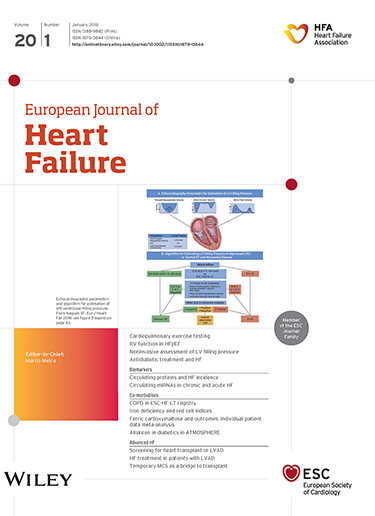高钾血症高危心力衰竭患者的管理:CARE-HK在HF登记中的应用。
IF 10.8
1区 医学
Q1 CARDIAC & CARDIOVASCULAR SYSTEMS
引用次数: 0
摘要
具有高钾血症高风险的心衰(HF)患者在前瞻性心衰登记中代表性不足。CARE-HK心衰登记旨在前瞻性地描述高钾血症高危心衰患者的临床特征、管理和结局。方法和结果scare - hk是一项跨国前瞻性登记的HF门诊患者(无论左心室射血分数[LVEF]),接受血管紧张素转换酶抑制剂/血管紧张素II受体阻滞剂/血管紧张素受体-neprilysin抑制剂(ACEI/ARB/ARNI)治疗,接受或潜在候选矿皮质激素受体拮抗剂(MRA)。所有患者的高钾血症风险增加,定义为基线高钾血症、既往高钾血症或估计肾小球滤过率(eGFR) <45 ml/min/1.73 m2。结果包括高钾血症事件的频率(由临床医生报告与相关钾值定义),肾素-血管紧张素系统抑制剂(RASi)优化的实现(定义为ACEI/ARB/ARNI和MRA的靶剂量≥50%),高钾血症发作后的药物变化和临床事件。总共纳入了来自9个国家111个地点的2558名患者。中位(25 -75)年龄为73(65-80)岁,32%为女性,61% LVEF≤40%,40%既往有高钾血症的实验室证据。中位基线eGFR和血清钾分别为44 (33-60)ml/min/1.73 m2和5.0 (4.4-5.3)mEq/L。在中位12.3(9.4-18.1)个月的随访中,29%的患者出现高钾血症事件,7%出现多重事件。在大多数随访中,29%的患者接受了最佳RASi/MRA治疗,69%接受了次优RASi/MRA治疗,3%未接受RASi/MRA治疗。在第一次高钾血症事件发生后的30天内,3.6%的病例降低或停止使用RASi/MRA。钾结合剂用量较低(聚吡咯烷9.1%,环硅酸锆钠5.9%)。与未发生高钾血症事件的患者相比,发生高钾血症事件的患者具有相似的全因死亡风险(风险比[HR] 1.22, 95%可信区间[CI] 0.92-1.62, p = 0.16),并且随后住院的风险更高(风险比[HR] 1.59, 95% CI 1.35-1.86, p < 0.001)。结论:在这项当代跨国前瞻性登记的高钾血症高危心衰患者中,高钾血症事件很常见,但很少与RASi/MRA修饰或钾结合剂使用相关。在大多数随访中,不到三分之一的患者接受了最佳的RASi/MRA治疗,高钾血症事件与不良临床结果的高风险相关。临床试验注册:clinicaltrials .gov NCT04864795。本文章由计算机程序翻译,如有差异,请以英文原文为准。
Management of patients with heart failure at high risk of hyperkalaemia: The CARE-HK in HF registry.
AIMS
Patients with heart failure (HF) at high risk for hyperkalaemia are underrepresented in prospective HF registries. The CARE-HK in HF registry sought to characterize prospectively the clinical profile, management, and outcomes for patients with HF at high risk of hyperkalaemia.
METHODS AND RESULTS
CARE-HK in HF was a multinational prospective registry of outpatients with HF (regardless of left ventricular ejection fraction [LVEF]) treated with an angiotensin-converting enzyme inhibitor/angiotensin II receptor blocker/angiotensin receptor-neprilysin inhibitor (ACEI/ARB/ARNI) and either receiving or potential candidate for a mineralocorticoid receptor antagonist (MRA). All patients were at increased risk of hyperkalaemia, defined as hyperkalaemia at baseline, prior hyperkalaemia, or estimated glomerular filtration rate (eGFR) <45 ml/min/1.73 m2. Outcomes included frequency of hyperkalaemic events (defined by clinician report with associated potassium value), achievement of renin-angiotensin system inhibitor (RASi) optimization (defined as ≥50% target doses for ACEI/ARB/ARNI and MRA), medication changes following hyperkalaemic episodes, and clinical events. Overall, 2558 patients from 111 sites across nine countries were included. Median (25th-75th) age was 73 (65-80) years, 32% were women, 61% had LVEF ≤40%, and 40% had prior laboratory evidence of hyperkalaemia. Median baseline eGFR and serum potassium were 44 (33-60) ml/min/1.73 m2 and 5.0 (4.4-5.3) mEq/L, respectively. Over a median follow-up of 12.3 (9.4-18.1) months, 29% of patients had a hyperkalaemic event, and 7% had multiple events. In characterizing treatment prescribed for most of follow-up, 29% of patients received optimal RASi/MRA therapy, 69% received suboptimal RASi/MRA therapy, and 3% received no RASi/MRA. In the 30 days following the first hyperkalaemic event, RASi/MRA was down-titrated or discontinued in 3.6% of cases. Potassium binder use was low (patiromer 9.1%, sodium zirconium cyclosilicate 5.9%). Compared with patients without a hyperkalaemic event, patients experiencing a hyperkalaemic event had similar risk of all-cause mortality (hazard ratio [HR] 1.22, 95% confidence interval [CI] 0.92-1.62, p = 0.16) and a higher risk of subsequent hospitalization (HR 1.59, 95% CI 1.35-1.86, p < 0.001).
CONCLUSIONS
In this contemporary multinational prospective registry of patients with HF at high risk for hyperkalaemia, hyperkalaemic events were common but infrequently associated with RASi/MRA modification or potassium binder use. Fewer than one in three patients received optimal RASi/MRA therapy for the majority of follow-up, and hyperkalaemic events were associated with higher risk of adverse clinical outcomes.
CLINICAL TRIAL REGISTRATION
ClinicalTrials.gov NCT04864795.
求助全文
通过发布文献求助,成功后即可免费获取论文全文。
去求助
来源期刊

European Journal of Heart Failure
医学-心血管系统
CiteScore
27.30
自引率
11.50%
发文量
365
审稿时长
1 months
期刊介绍:
European Journal of Heart Failure is an international journal dedicated to advancing knowledge in the field of heart failure management. The journal publishes reviews and editorials aimed at improving understanding, prevention, investigation, and treatment of heart failure. It covers various disciplines such as molecular and cellular biology, pathology, physiology, electrophysiology, pharmacology, clinical sciences, social sciences, and population sciences. The journal welcomes submissions of manuscripts on basic, clinical, and population sciences, as well as original contributions on nursing, care of the elderly, primary care, health economics, and other related specialist fields. It is published monthly and has a readership that includes cardiologists, emergency room physicians, intensivists, internists, general physicians, cardiac nurses, diabetologists, epidemiologists, basic scientists focusing on cardiovascular research, and those working in rehabilitation. The journal is abstracted and indexed in various databases such as Academic Search, Embase, MEDLINE/PubMed, and Science Citation Index.
 求助内容:
求助内容: 应助结果提醒方式:
应助结果提醒方式:


